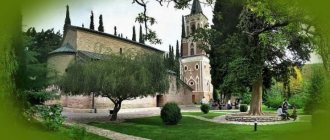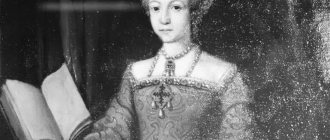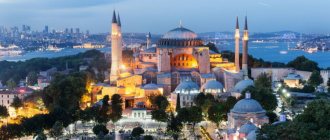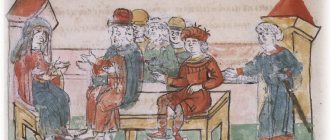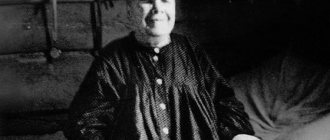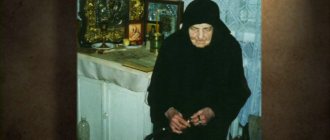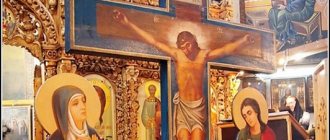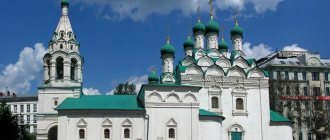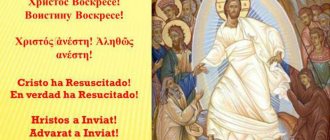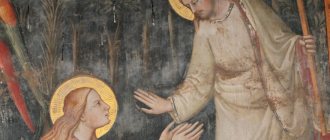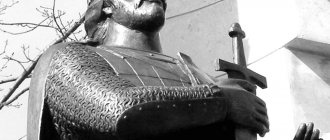| Saints Faith, Hope, Love and their mother Sophia |
Sophia of Rome
(+137), martyr Memory September 17
The pious Christian widow Sophia lived in the century, during the reign of Emperor Hadrian (117-138), in Italy. Having named her daughters, Faith, Nadezhda and Love, after three Christian virtues, Sophia raised them in love for the Lord Jesus Christ.
Saint Sophia and her daughters did not hide their faith in Christ and openly confessed it before everyone. The rumor that this family belonged to Christianity reached the emperor, and he ordered them to be brought to Rome. Understanding why they were being taken to the emperor, the holy virgins fervently prayed to the Lord Jesus Christ, asking Him to send them strength not to be afraid of the upcoming torment and death. When the holy virgins and their mother appeared before the emperor, all those present were amazed at their calmness: it seemed that they were invited to a bright celebration, and not to torture. Calling his sisters one by one, Adrian convinced them to sacrifice to the goddess Artemis. The young maidens (Vera was 12, Nadezhda - 10 and Lyubov - 9 years old) remained adamant.
Then all three were subjected to severe torture. Enduring unprecedented torment, the holy virgins glorified their Heavenly Bridegroom and remained steadfast in their faith. Saint Sophia was subjected to another, most severe torture: the mother was forced to watch her daughters suffer. But she showed extraordinary courage and all the time convinced the girls to endure torment in the Name of the Heavenly Bridegroom. All three girls joyfully met their martyrdom. They were beheaded in 137. Sofia was not put to the test, perhaps out of the calculation that by leaving her life, they would also leave her hopeless grief over the loss of her children.
The emperor allowed Saint Sophia to take the bodies of his daughters. She put the remains in an ark and took them outside the city and buried them in a high place. For three days Saint Sophia, without leaving, sat at the grave of her daughters and, finally, there she gave up her soul to the Lord. The believers buried her body in the same place.
Saint Sophia, who endured great mental anguish for Christ, together with her daughters, was canonized by the Church.
Field of Dreams
At the beginning of the 15th century, the Spanish diplomat and traveler Ruy Gonzalez de Clavijo was most struck by the marble slab with the image of the Mother of God, the Child and John the Baptist right in the veins of the stone in Hagia Sophia.
In Ottoman times, obsessive local guides in turbans showed travelers the palm sign on one of the columns, at a level of five meters from the floor - according to legend, Mehmed II the Conqueror himself, on the day of the capture of Constantinople on May 29, 1453, rode into the temple on a horse, the horse reared up on the mountain of corpses and Mehmed leaned on the marble with his bloody hand. And if before the transformation of Hagia Sophia into a mosque you would have gone to the museum with a Turkish guide, he would have taken you past Byzantine antiquities like a rocket and shown you the miraculous profile of Ataturk in the streaks of the jasper wall, right next to the nave. Travelers of the past left us many descriptions of Sofia. But miracles have always been at the center of her myth. They are still piled up in Sofia today, like a historical attraction. Here is a trace in the wall in which the priest, who served the last service on the day of the conquest of Constantinople, hid. “When Saint Sophia becomes Christian again, the wall will open, the priest, emerging from his hiding place, will return to the altar to finish the service begun 400 years ago” (Théophile Gautier, “Constantinople”, 1853). Here is the column of St. Gregory, wet from the inside, which pilgrims came to touch for healing back in Byzantine times. “They rub their hands and arms around the pillar to cure illness,” wrote the Russian pilgrim Anthony of Novgorod in 1200. Here is the pillar where, as any resident of Constantinople knows, the angel of the temple lived - on the night of the conquest, the angel, according to the testimony of Nestor Iskander, a Christian in the Ottoman army, went into the sky in a pillar of fire “becoming like an indescribable light.”
Historical Picture Archive/CORBIS/Corbis via Getty Images
Hagia Sophia, early 19th century, color lithograph
Operating mode. Cost of visit
- Opening hours : from 09.00-19.00 (summer schedule, from April 15 to October 30), from 09.00-17.00 (winter schedule, from October 30 to April 15). The museum is closed on Mondays.
- Cost of visit: 72 TL . You can pay with a bank card. Tickets stop selling one hour before closing. Children under seven years old are admitted free of charge. You can save money when visiting this museum by using a museum card .
Myth Factory
Under any power, Sophia became an important symbol. For its builder, Emperor Justinian, it was a symbol of the greatness of his reign - he erected a monument thanks to which his name will be remembered for centuries. Sultan Mehmed II saw himself as the Sultan of a new, Muslim Rome, and the temple for him was a symbol of continuity of power, as well as a turn to the West, where, to the great displeasure of many of his Muslim comrades, his empire would henceforth look. For Ataturk, Sofia also became a symbol - a new secular, enlightened Turkey, a source of knowledge for humanity. Well, for Erdogan it is a symbol of the fact that Turkey is forced to be taken into account in the world, in particular because in general there is nothing to say to the world against the next transformation of Sofia according to the letter of Turkish law.
The history of that Sophia, about which spears are struck today, began in 532 AD, when Emperor Justinian decided to rebuild the Constantinople Church of Hagia Sophia, destroyed during the Nika uprising, so that it would have no equal in the world. Two Greeks - the mathematician Anthimius from Thrall and the architect Isidore from Miletus - came up with a grandiose structure, the huge dome of which rested so gracefully on two half-domes that the building, despite its gigantic volume, seemed weightless.
Alamy/Legion Media
Virgin and Child and Islamic calligraphy in Hagia Sophia, 2021
Sophia was intended to amaze not from the outside, but from the inside, shining with golden decoration and the light of thousands of golden lamps. She impressed the crusaders so much that on April 12, 1204, they captured Constantinople and took everything out of it.
Just under a thousand years later, on the day of the fall of Constantinople, May 29, 1453, a new owner, the 19-year-old Ottoman Sultan Mehmed II the Conqueror, entered the temple. A witness described how Mehmed “arrived at the square near the great church, dismounted from his horse, fell prostrate to the ground, took a handful of earth and sprinkled it on his head, thanking God. And he marveled at this huge building, saying: “Truly these people were and left, and after them there will be no others like them.”
Origin of the name Sophia
This name is considered ancient Russian, having its roots in the same ancient Greek meaning “wisdom”. It is no secret that most of the names in Rus' migrated precisely from the ancient Greek language and from Byzantium, the center of Orthodoxy. If we consider the etymology, this name is also associated with the early Christian Saint Sophia, the mother of three daughters of the great martyrs. However, it is Sophia who is considered the patroness of the female line of the royal family in Russia. Therefore, among the nobles of the second half of the 19th century, the custom of calling their newborn daughters with this name was so widespread.
Golden domes
Mehmed the Conqueror received the city and the temple in a very deplorable state. But he almost didn’t touch it: he redid the mihrab to redirect worshipers from the east (Jerusalem) to the southeast (Mecca), added a minaret, and another minaret was added by his son, Bayezid II.
In the 70s of the 16th century, Sultan Selim II, the son of Suleiman the Magnificent, started a massive reconstruction of the trophy temple. Perhaps this reconstruction saved Hagia Sophia, and thanks to it the building has survived to this day. The architect Sinan, on his orders, erected two more minarets and strengthened the building with massive buttresses, and instead of the houses attached to the mosque, he erected a mausoleum for the Sultan, where he still lies. The drawings of those times, by the French artist Guillaume Grelot (1680) and the Swedish diplomat Cornelius Loos (1710), show many mosaics that have not survived to this day - they were threatened not so much by plaster as by the Istanbul earthquakes.
Only in the 17th century did the Turks become concerned about the conformity of the inside of the temple with Muslim tradition and covered the images with plaster. Eight-meter wooden shields with calligraphic inscriptions appeared in the temple even later. They were painted by order of Sultan Abdulmecid I by the famous Ottoman calligrapher Kazasker Efendi. At the same time, the Sultan called the Swiss Gaspare Fossati, who arrived in 1847 to build a new Russian embassy building (it still stands on Istiklal), to repair the crumbling mosaic pattern of the temple. Fossati, without further ado, went over the paint and at the same time sketched the mosaic icons that he saw during the restoration. Many of them crumbled during the next big earthquake and have survived to this day only in these drawings.
However, according to Gerard de Nerval, who visited Constantinople at the beginning of the 19th century, the mosaics turned out to be “lightly smeared”; Nikolai Gumilyov in 1913 saw the shadows of angels shining through the plaster on the walls of Sofia; “Ghosts of dead Byzantine mosaics shining through the whitewash” were also seen by Ivan Bunin in 1907.
In general, Sofia required constant repairs, and the Turks did not refuse it. Moreover, the conquerors were so fascinated by Sofia that they built Istanbul mosques in its likeness. This is undoubtedly the merit of the great architect Sinan, who in his majestic imperial mosques repeated the image of Sophia again and again - the same dome lying on two half-domes, the same feeling of light filling the temple from within. The Blue Mosque opposite Hagia Sophia was completed after Sinan, in 1616 - now they look at each other, and a new Istanbul tourist will not immediately be able to distinguish one dome from the other.
Emperor Constantine IX Monomakh and Empress Zoe. Worship of Christ, 11th century
Alamy/Legion Media
One of the main works of Byzantine art is the Deesis: the Mother of God and John pray to Christ for the salvation of the human race. Part of the mosaic has been destroyed.
LiveInternetLiveInternet
Sophia - Wisdom of God - Winged Isis. Holy Lady
Isis. Our Lady
The Christian cult is eclectic*. It also absorbed the cult of Mithras (which designated December 25), Horus (December 25) from the cult of the Mother Goddess Isis (and in ancient times this was generally one of the main objects of worship - Astarte, Cybele, Devi, Shekinah, etc. ). The worship of the Mother of God (note! not the mother of the son of God, but precisely the MOTHER OF GOD) came to Christianity from more ancient eras. The mother archetype is one of the most ancient, and it has its place of honor both in the subconscious of each individual person and in the collective unconscious... The cult of the Goddess is, in fact, very ancient, found in the religions of all peoples of our planet. Which makes it easier to find the “missing details” in the whole picture. After all, some details were preserved in some traditions, and some significant ones were preserved in others. The cult of the Female Goddess has echoes in Christianity. But exclusively as a cult of the Mother of God.
Sophia stands on an eminence, beneath Her are seven degrees of perfection (seven eons of Gnostics, chakras of yogis). According to the Apocalypse of John (2:1), before the end of the world (cycle), a Sign will appear in Heaven - “A Woman Clothed in the Sun; The Moon is under Her feet, and on Her head is a crown of twelve stars.” But this is the image of the same Sophia standing on the Moon, whose body radiates Light. Sophia rests not only on the crescent (Moon), but also on a ball entwined with a serpent. This symbol is already familiar to us... We can only be surprised that, recognizing God the Father as their Heavenly Father and striving for him, Christians do not say anything about their Mother. Like orphans. But if some people yearn for their Heavenly Father and direct their gaze to the sky-high heights, then the Mother generally remains almost completely forgotten. God the Father is “there,” but where is God the Mother, where? And if God the Father is Love, then who is God the Mother? Most people don't even ask this question. The Bible really doesn’t say much about this, but, for example, in the already famous Dead Sea Scrolls (Qumran Scrolls), one non-canonical Gospel (which is attributed to the Essenes, and according to other scientific researchers - to the Sadducees) speaks of the Mother of humanity, well, simply revealed text: “... “Blessed are you who seek the truth, for I will help you and give you the bread of wisdom. Blessed are you who want to break free from the power of Satan, for I will lead you to the kingdom of the angels of Our Mother, where the power of Satan cannot penetrate.” And with great surprise they asked: “Where is our Mother, and who are her angels? Where is Her kingdom? “Our Mother is in you, and you are in Her. It was She who gave birth to us and gave us life. It is from Her that you received your body and the day will come when you must return it. Blessed will you be when you can know Her. Hers and Her kingdom, when you follow Her laws. Truly I say to you: whoever achieves this will never see illness, for the power of your Mother rules over everything. And this power destroys Satan and his kingdom, and the law of your Mother rules over everything and governs your bodies in the same way as all those living on Earth...”
The great Mother is also openly proclaimed in other apocryphal gospels: “... And she surrounded him with a bright cloud and placed a throne in the middle of the cloud, so that no one would see him except the Holy Spirit, who is called the mother of the living” Apocrypha of John, 10; “The mother is the truth” (the Bible says “And the Lord God is the truth” Jeremiah 10:10); “Some said that Mary conceived by the Holy Spirit. They are mistaken. They don't know what they say. When has it ever happened that a woman conceived from a woman? ..." Apocryphon "Gospel of Philip", 17, 110; “My mother, the Holy Spirit” Apocryphon “Gospel of the Jews”;
“I am She who is called “Truth.” Apocrypha "Thunder. Perfect Mind." The Holy Spirit of Truth, the Wisdom of God - Sophia - or the World Soul (Anima Mundi), separated as a result of a free act of will from God. But only the Absolute could allow itself such an autonomous existence. Consequently, the third hypostasis of God - Sophia - is the Absolute in female form. It is Sophia who is the link that connects a person with God. The Gospel of John the Theologian says: “The Comforter, the Holy Spirit of Truth, whom the Father will send in My name, will teach you all things and remind you of everything that I have said to you” (John 14:26). Also: “I still have much to say to you, but now you cannot bear it. When He, the Spirit of Truth, comes, He will guide you into all truth” (John 16:12-13). Taken from the source. https://www.krupaspb.ru/forum/ “... 33. THE HOLY SPIRIT - THE WINGED ISIS The Christian symbol of the Holy Spirit is depicted as a dove with outstretched wings. The main Egyptian symbol is the solar disk in the outstretched wings of an eagle, in the vestment of two snakes, which means the Wisdom of God (Earthly and Heavenly Wisdom). This is the Symbol of the Supreme Spirit, which, like the Sun, permeates all living things. The Gospel of John (1:32) says: “And John testified: I saw the Spirit descending from heaven like a dove, and remaining on him.” The Spirit of God's Revelation Came upon Jesus, and only then did Jesus feel that He was the Christ. In the “Revelation of John the Theologian” the outline of the True Teaching taken from Egypt is also visible. I will cite just one episode that clearly testifies to the Truth. Chapter 12 reveals one of the main Apocalyptic signs of the end times: the Appearance of the “Woman Clothed with the Sun.” “And a Great Sign Appeared in Heaven: a Woman Clothed in the Sun; Under Her feet is the Moon, and on Her Head is a crown of twelve Stars. She was pregnant, and screamed from the pain and pangs of birth." (12:1, 2). “When the dragon saw that he had been cast down to Earth, he began to pursue the Woman, who gave birth to a male Child. And the Woman was given two wings of a great eagle, so that She might fly into the wilderness to Her place from the presence of the serpent...” (12:13, 14). This is very reminiscent of the story of Isis, who, together with the Child Horus, was put in prison by Seth. The two wings of a large eagle are characteristic of Winged Isis - the Mother of the Gods.
34. PROPHECIES ABOUT MARIA DEVI CHRISTOS April 11, 1990 The planetary Manifestation of the Holy Spirit took place in the Mother of the World Maria DEVI Christos - New Isis. From that very moment, the dragon began to pursue the Wife. When, in 1993, the totalitarian serpent of Orthodoxy, led by the special services, put the Mother of the World in prison with Her Infant Horus - John Peter the Second - the biblical prophecy was fulfilled. I will not consider in detail the Jewish Bible, the scripture of Christians around the world, but even speaking about these important symbols, the picture emerges clear: everything comes from Egypt, the Ancient Vedas and the Mother of the Gods. And no patriarchal system will create a religion more spiritual and complete than the religion of the Woman-God. And now, let’s briefly touch on our modern times. The appearance of the Mother of the World on the Slavic land was predicted from ancient times. This was also said in the ancient Egyptian scrolls, Nostradamus, the Mother of God, Jesus Christ, in the Vedas, Vl. Solovyov, Sarovsky, Sonoran elders, Helena Roerich, Daniil Andreev, “The Revelation of John the Theologian” captures this Event. Although the canon replaced the Female Image of God with a Male Image, to the Theologian, nevertheless, the Lord Appeared in the Image of a Wife, and not even a virgin. Moreover, he knew about the future Appearance of the Comforter from the lips of his Beloved Teacher. The canonized “Old Testament” also has this evidence. “Genesis” proclaims that the Woman will smite the serpent directly on the head with Her Seed, “The Book of the Proverbs of Solomon” and the “Book of the Wisdom of Solomon” openly speak about the Role of the Mother, the Wisdom of God, the Holy Spirit, the same can be found in the “Book of the Wisdom of Jesus, the Son of Sirach ", even the prophet Isaiah cannot restrain himself and announces the "Crown of Glory of the Lord", the "New Name", "My Favor to Him", about the Mother who must defeat the Darkness: "Not a single weapon made against You will compete with You in court, - You will accuse." (54:11-17). Other prophets also speak about the Mother: Jeremiah, Baruch, Micah, Zephaniah, Zechariah, Malachi, the Third Book of Ezra, “Song of Songs” by Solomon. So, there is quite enough evidence for this Phenomenon!” (Mother of the World Maria DEVI Christos. “REVELATION OF THE HOLY SPIRIT, or finally become sighted!”). https://usmalos.com/modules.php?name=EpohaSveta&pa=showpage&pid=9&page=2 V. Solovyov in his “Sophie “predicted that: “Sophia, the Wisdom of God, ends her Stay on Earth in the Quality of God, as evidenced by the sixth stage of Her Perfection - Grace... After Grace, Glory awaits Sophia... New essential knowledge about Man, God and the Universe will appear on the eve of the Age of Aquarius on territories of Russia and Ukraine..." (V.S. Solovyov, 6th letter, 1875). “Ten Divine Faces of Hagia Sophia”https://usmalos.com/modules.php?name=UsmalosWorld&pa=showpage&pid=45
“... Face tenth Russian Sophia. This is a national aspect. The philosopher believed that the all-human cosmic deity would become human in the situation of the “end of the world” precisely in the Russian woman philosopher. After all, it was the Russian people who distinguished Sophia from the Holy Virgin Mary, and Christ from Jesus Christ. Sophia was for him an independent Heavenly Essence, hidden, under the appearance of the lower world, the radiant spirit of reborn humanity, the guardian angel of the Earth, the coming and final Manifestation of the Divine.” Mother of the World - Epochal Teacher of the New Era - The First Who Shattered the Age-Old Dogmas and Canons of the Patriarchal World and Opened the Face of World Femininity, Gave Her Spiritual “Science of Light and Its Transformation”, Legalized the Order of Things in the Universe, Revealed the Mystery of the Pyramid, Opened the Law of Eternity, Balanced the Two Opposites Beginning, Husband and Wife on the Universal Scales. Maria DEVI Christ Gives the world a New World Outlook and Perfect Knowledge of the Absolute, Establishes a New Culture in Which Her Voice, Word, Singing Sounds; The Spiritual Dance is revealed. The Mother of the World Connected Heaven and Earth, Spiritual and Material, Creating Absolute Omniscience, Man.
Maria DEVI Christ, through the Highest Form of Manifestation of Spirituality - Art - Opened the Worlds of the Universal Cosmic Reality to earthlings, Deepened the Sacred Knowledge, and most importantly - Completely Revealed Her Hidden World - the Absolute Ein-Soph, Embodied in the World of Matter. Divine Knowledge, which was hidden before time, is now Opened by the Mother of the World. There is no longer anything secret - everything secret has become clear! “Cosmic Polyart of the Third Millennium by Victoria PreobRAzhenskaya” Became the final stage of the Divine-Cosmic Program YUSMALOS.
Sophia the Eternal Sophia - Light of Lights! Descended from Heaven, Beautiful-Winged! You are to Carry out Your Judgment over the Darkness of Ages! And fill the new World with God's Power! The time is coming! Soon the Deadline will strike Your Ecumenical Glory for the Salvation of Suriya Rus'. Your Tribe is waiting for You, Maitreya! Mother of Forgiveness! Your Divine Face was plucked from the Altar, Your Sacred Houses were destroyed. But the Earth Itself proclaims about You, revealing Your Imperishable Images. Sofia! Mother of Fire, Earth and Waters! Mother of the Universe! Mighty, United! Under Your Protection Holy Rus' Will Rise - The Invincible Heavenly Army! Mother Surya! You Came as a Human to earthlings: You brought Salvation... But people will not understand You forever until they achieve Transfiguration. And only Your White Tribe Steps under Your Holy Banners! You will forgive Your Creation again - for Your Passion on the Cross, the Crucified Ways... 01/14/2011 Victoria PreobRAzhenskaya
The Victory of Light has already happened! The Mystery of the Apocalyptic Woman, Clothed in the Sun, took place in all Worlds and Spaces. And there is nothing that can stop Victoria Transfiguration! HOORAY! YUSMALOS! AUM-YIN! More details on the website www.victoriara.com Elena Kraevskaya
Sofia for Russians
It took the city's Muslims several centuries to accept Sophia Mosque as their own. It turned out to be more difficult to part with the idea of Sophia the Temple. Not only the Greeks, who consider Sofia theirs, regularly return to her, but also the Russians, who also think so. Not entirely without reason, of course - after all, our Christianity is Byzantine, and it was the inner gold of Sophia that influenced the choice of religion by the ambassadors of Prince Vladimir, and Sophia can well be considered the prototype of many Russian churches (Sophia of Kiev and Novgorod, not to go too far), and We know quite a lot about what Sofia was like before the conquest from the records of Russian pilgrims from Constantinople.
Dreams of the revival of Constantinople begin with the “Greek project” of Catherine II - she dreamed of conquering Constantinople and making it the capital of a new Orthodox state, where her grandson, whom she strategically named Constantine, would rule. And although the Greek project could not be realized, Catherine still built her little Constantinople, Tsarskoe Selo, with her little Sofia.
Several times it seemed that these dreams would come true: in 1829, when Russian troops stood at Edirne; in 1878, when the Russian army reached Yeşilkei, a region of Constantinople, but retreated under British pressure. Well, these aspirations seemed most realistic during the First World War. “It is not washed away, no, oh, Turks, / The clearest of evidence, / That again from under the plaster / The face of the Savior will shine for us” (Mikhail Kuzmin, “Tsargrad”, 1915).
By turning Sofia into a museum, Ataturk symbolically took it away not only from Muslims, but also from Orthodox Christians - for 86 years it was a common monument, and not a source of interfaith strife. This won't happen again.
Yuksel Goz/Unsplash
Prayers
Troparion, tone 4
The Church of the Firstborn triumphs,/ and the mother of the same name rejoices in receiving the joy of her children,/ like the wisdom of the same name/ with the triple theological virtue of equal race./ You are with the wise virgins she sees the Bridegroom, God the Word, who has become ignorant, / with her and we, spiritually, rejoice in their memory, saying: / Trinity champions,/Faith, Love and Hope,//confirm us in faith, love and hope.
Kontakion, tone 1
(Similar to: Thy Sepulcher, Savior:)
Honest Sophia, the most sacred branches, Faith and Hope and Love, appearing,/ wisdom enshrouded by Hellenic grace,/ both the sufferer and the victorious one appeared,/ an incorruptible crown// from all Vlad Christ's hooves are tied down.
Nobody's business but the Turks
Calls for Sofia to be restored to mosque status have not ceased since the historic decision in 1934, but in recent years, flirtations with this topic have become one of the favorite topics of domestic politics. But just recently, President Erdogan said that the train for these changes had left. “First fill the Blue Mosque,” he responded a year ago to a request to make Sofia a mosque. Not the least important role was played by the fact that the Sofia Museum was the most profitable tourist attraction in the city: according to various estimates, it brought in up to $75 million a year.
Sofia was destroyed by coronavirus. The printing press stopped, the ratings of the president and his party plummeted, and it was urgent to unite the splitting and rapidly scattering society around some kind of national idea. Did all Turks dream of the Sophia Mosque? Most of them had never seen it at all and had no idea about its complex history. But the very talk about a possible transition was able to distract people from coronavirus reports and economic troubles. When polls showed that 70 percent of Turks approved of Sofia's conversion to mosque status, its fate was sealed. The symbolic benefit - the unity of Turkish society - turned out to be higher than the material one.
And not the least role in this issue was played by the objections of Greece, protests from Russia and other international attempts to stop the process. Every note of protest was met with hostility - and strengthened the desire to show the world who is boss in this house. “Objections regarding the status of Hagia Sophia are a direct interference in Turkey’s sovereign affairs,” President Erdogan said; after all, we are not remodeling a church, but a museum.
Alamy/Legion Media
Interior of Hagia Sophia
This is not to say that there are no votes against it at all. Nobel laureate Orhan Pamuk told the BBC that "millions of secular Turks are shouting against it, but their voices are not being heard." For them, the change in the status of Hagia Sophia means the end of the dream of a secular Muslim state. Others worry about how the transition will affect Turkey's international brand. Still others, including Istanbul Mayor Ekrem Imamoglu, fear international consequences.
But so far the victory is bearing fruit - Turkish society is united in rejoicing that everyone around is so irritated. Will this jubilation be enough to propel Erdogan's party to victory in the next elections? To be sufficient, these elections must take place much earlier than 2023.
In culture and religion
The name became popular not only among the Slavs. The British and the people of Ireland liked it. In 2010, every second Ukrainian family named their daughters this way. In the world, the name Sofia occupies third place in the popularity list. This is the most common name in Bulgaria; the capital of this state bears the same name.
The name was extremely common among the royalty of European states. At different times in history, Sophias were at the head of state: the queens of Prussia, Greece, Norway, Sweden, the Duchess of Bavaria and the Princess of Alden.
The canonical church has at least a dozen saints with the name Sophia; it is the spelling with the soft sign that Orthodoxy considers true. Sophia's name day is celebrated on September 30 in honor of her mother and martyr. In addition to this date, the Orthodox Church celebrates Angel Day several more times a year: in February, April, June, October and December 31. Catholics with the name Sophia were given two days - in May and October.
In Russian literature, the most famous characters with the name are Sonechka Marmeladova from the novel “Crime and Punishment”, Sofya Pavlovna from “Woe from Wit”, it is found in Fonvizin’s play and Tolstoy’s novel. Sonya the Golden Hand became a legend of the criminal world, and the famous Aunt Sonya from Odessa became the heroine of numerous jokes. By the way, translated from Hebrew, Sofa means “forever young”, from Arabic it means “smart”, and from Hindi it means “golden”. The names sound different, but the origin is common.
